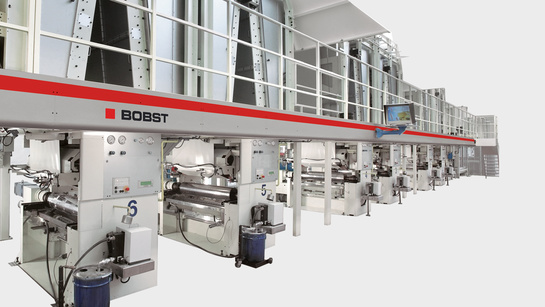
In intaglio or gravure printing ink is transferred from a sunken surface. It is the reverse of relief printing. One type of industrial intaglio printing. Gravure sometimes called rotogravure, shown in the image uses a recessed- image plate cylinder to transfer the image to the substrate. the plate cylinder can be either chemically etched or mechanically engraved to generate the image cells. The image area consists of cells or wells etched or engraved into a copper cylinder and the unetched surface of the cylinder represents the nonprinting areas. the image cylinder rotates in a bath of ink. The excess ink is wiped off the surface by a flexible steel doctor blade. The ink remaining in the thousands of recessed cell form the image by direct transfer to the paper as it passes between the plate cylinder and the impression cylinder.
Gravure Cyclinder & Plate
Gravure is an intaglio process in which the image areas are engraved in the form of cells in a thin copper shell plated on a steel cylinder. Gravure can print varying amounts and densities of ink to produce images that simulate continuous-tone images. The intaglio cells that compose the images vary in the volume corresponding to the tonal values in the images. Two processes for producing the cells represent two different types of cells. Conventional gravure with constant area variable depth cells and Electromechanical engraving (EME) produce variable area-variable depth cells.
On the basis of manufacturing gravure cylinder and plates are categorized as follow:
- Conventional Gravure- In this, a special mask is prepared by exposure through a special gravure screen and then through a film positive. This mask is applied to the gravure cylinder and with the help of chemical etching the cylinder is developed. After development, the cylinder is chrome plated.
-
Electromechanical Engraving- In this process, a photographic print as an input unit is mounted on one rotating drum. It is scanned by reading heads with the help of a light beam. The information from the light single is stored in the computer and translated in the motion of a diamond stylus mounted on the other cylinder. After cutting the cylinder is chrome plated.
-
Laser Gravure etching process- In this process, a series of small holes or wells is chemically etched over the entire surface of a clean copper cylinder. These holes are filled with a plastic material until a smooth surface is achieved. Like the electromechanical process originally is scanned by a beam of light and etching on the cylinder is done with the help of laser light.
-
Photopolymer Gravure- In this process Photopolymer coating on stainless steel plates can be mounted on a magnetic cylinder. These plates are similar to relief plates except the image area is recessed. In this case, while printing steel or a special plastic doctor blade is used.
-
Gravure Computer to Cyclinder System- This is a filmless gravure process. In this, digital information from the prepress system is fed directly to the computer which converts digital signals to electrical impulses that are fed to the diamond styli in the engraving heads that produces the printing cells.
Application of Gravure-
The gravure market can be considered to comprise three approximately equal segments that are as follows publications, packaging, and specialty printing. In publications, gravure retains a significant proportion of the long-run magazine market. In packaging printing, in which paperboard and repeat-run cartons are encountered gravure is the ideal process. The cylinder lasts virtually forever and color consistency is high. The final third of the gravure market is specialty printing of such items as wallpaper, gift wrap, and floor coverings.
Advantages & Disadvantages of Gravure-
The fundamental strengths of gravure are that the process provides consistent color throughout long print runs and because of its ability to apply for heavy ink coverage, can be used to print high-quality work or to print on a lower grade of paper than offset lithography while maintaining acceptable print quality.
In contrast, the primary process disadvantages of gravure are long lead time, high cost of manufacture for gravure cylinders, generally long press make-ready times, and environmental hazards associated with the use of solvent-based inks.
Gravure Inks-
Gravure inks are rapid-drying inks that must have the proper viscosity to be drawn by capillary action from the engraved well in the cylinder or plate. It is composed of pigment, resin binder, and most frequently a volatile solvent. They dry principally by the evaporation of the solvent in the ink, with or without the use of heat. Gravure ink must be free of abrasive particles that could scratch the engraved cylinder or plate. Gravure printing uses two major kinds of ink: publication ink and packaging ink. Publication ink basically consists of modified resins, pigments, and hydrocarbon solvents. Most packaging ink is formulated with nitrocellulose and various modifiers. A wide variety of solvents are used in gravure depending on the substrate. Most gravure inks are very volatile and can cause fires or explosions if not handled properly. Solvent recovery is used in many publication plants to eliminate pollution from evaporated solvents. Water-based inks have been developed mainly for packaging to eliminate both fire hazards and solvent pollution.
To know more about Printing Technology, you can buy "The Big Book of Packaging" on Amazon - https://amzn.eu/d/epnBqsi






